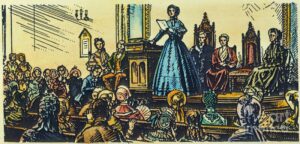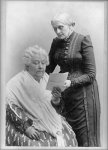By Etsub Taye
A Case for Equal Rights

In 1848, the first women’s convention was held in Seneca Falls, New York. At the convention “The Declaration of Sentiments” was drafted to assert the natural rights of women as being equal to the natural rights of men. The author, Elizabeth Cady Stanton, mimicked the language and structure of “The Declaration of Independence,” using evocative language to draw comparisons in order to advocate for the equal rights of women. However, despite drawing a parallel between the two documents, Stanton failed in elevating her document to revolutionary status.

Stanton’s decision to draw a comparison between women’s rights to a document written 72 years prior was strategic because it captured the attention of its audience. Furthermore, the document repeats the philosophy of John Locke’s “Second Treatise of Government” which declared that all people had a natural or inherent right. Knowing the influence of Locke on Jefferson, Stanton showcased the validity of her argument by describing the disenfranchisement of women in a list of grievances. Stanton wrote “he has” then would interchange a strong verb to evoke emotion. She employed the use of words like “suffer,” “deprive,” “abuse,” over 40 times to compel sympathy. [1] Like Jefferson, Stanton used passive language to showcase women’s injuries. This allowed her to emphasize that women were being barred from accessing their natural rights which as a result gave her standing to protest for change.
The caveat to modeling The Declaration of Sentiments so heavily on The Declaration of Independence however is that it was always going to be overshadowed. Its lack of originality prevented it from ever achieving the same amount of lasting notoriety.

It is also important to recognize that Stanton was petitioning for the rights of educated wealthy white women like her, not for all men and women. She does not explicitly advocate for the rights of the enslaved. Moreover, unlike “The Declaration of Independence,” Stanton does not fully commit to protesting like Jefferson. Her call for women to demand “equal status to which they are entitled” diverges from Jefferson’s call to colonists to “alter their former systems of government.” Stanton’s aim was not to separate from the current government but to work within it. [2] This is not surprising since the resolution for women’s right to vote at the convention was a point of contention among delegates in 1848. Given the public reaction to the document, many women of the convention were hesitant to be radical in fear of their lives.

When further comparing the two documents, “The Declaration of Sentiments” demonstrates their fear as it lacks force. For instance the document “insists” on equal rights and promises to pursue them by stating “we shall employ agents, circulate tracts, petition the pulpit and the press on our behalf.” [3] The forms of protest they chose to make were significant but not nearly disruptive enough to be revolutionary. Nevertheless, the efforts of Stanton and “The Declaration of Sentiments” should be celebrated and remembered. Although the document didn’t warrant immediate change it served as a foundation for the suffragist movement.
Excerpt from “The Declaration of Sentiments,” Seneca Falls Convention (1848), read by Etsub Taye
Footnotes:
- Elizabeth Cady Stanton, Declaration of Sentiments, July 19, 1848, Seneca Falls, NY, Reproduced by the National Park Service
- Stanton, Declaration of Sentiments; Thomas Jefferson, et al, Declaration of Independence: A Transcription, July 4, 1776, Philadelphia, PA, Reproduced by National Archives
- Stanton, Declaration of Sentiments
